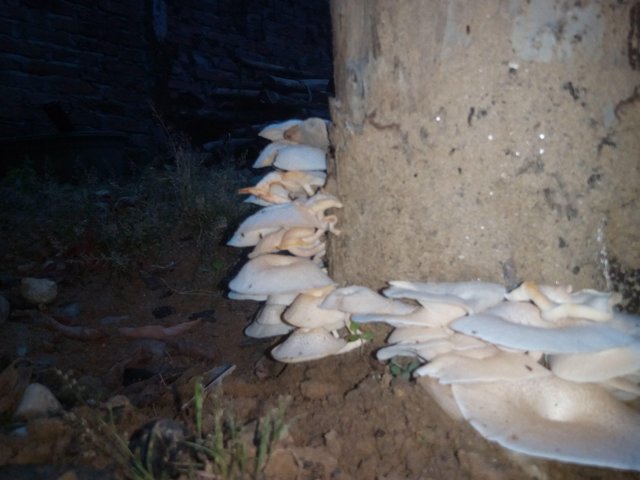Pleurotus ostreatus

The oyster mushroom body has a sideways grove (Latin: pleurotus) and oyster-shaped (ostreatus) so that the oyster mushroom has the binomial name Pleurotus ostreatus. [2] The hood part of the fungus changes color from black, gray, brown, to white, with an almost slippery surface, a 5-20 cm diameter with smooth edges with a slightly curved hood. [1] In addition, oyster mushrooms also have stem-shaped spores measuring 8-11 × 3-4μm and white miselia that can grow quickly. [1]
In the wild, oyster mushrooms can be found almost throughout the year in the cool mountainous forests of the region. [3] Fruit bodies seen overlapping on the surface of decayed tree trunks or stems of tree trunks that have been felled because the oyster mushroom is one type of wood fungus. [3] For that, when want to cultivate this fungus, the substrate must be made to consider the natural habitat. [4] The common medium used to breed oyster mushrooms is sawdust which is a waste from sawmill. [4]
Life cycle Edit
In general, oyster mushrooms, Pleurotus ostreatus, undergo two types of breeding in its life cycle, ie asexually as well as sexually. [5] As well as asexual reproduction of fungi, asexual reproduction of basidiomycota generally occurring through an endogenous spore pathway in its spore or sporangium sac, its asexual spores called conidiospores are formed in conidium. [6] While sexually, reproduction occurs through the unification of two types of hyphae which act as male gametes and females form a zygote which then grows into adult primodies. [6] Sexual spores in white oyster mushrooms, also called basidiospores located in the basidium sac. [6]
At first the basidiospores mimic form a monocharyotic mycelium, the mycelium with a haploid nucleus. [6] The mycelium continues to grow until the hyphae in the mycelium fuses with other compatible hyphae causing plasmogamy to form a dikaryotic hyphae. [7] After that when environmental conditions permit (temperatures between 10-20 ° C, moisture 85-90%, sufficient light, and CO2 <1000 ppm) then the fruit body will form. [8] The formation of the fruit body accompanied the occurrence of kariogami and meiosis in the basidium. [7]
The meiotic haploid nucleus then migrates to tetrad basidiospores in the basidium. [7] This basidium is located on a slab or bulkhead in a large number of adult mushrooms (lamela). [6] From this detached spore will develop into a mono-phonic hyphae. [6] This hyphae will lengthen its filaments by forming a branch of the formation of two nuclei bounded by a septum (one septum a nucleus). [6] Then the mono-mononic hyphae will accumulate to form a white connecting connective tissue called the early mycelium and eventually grow into adult mycelium (a collection of hyphae dikarion). [6] In this stage, hyphae have undergone plasmogami, kariogami, and meiotic stages to form mushrooms. [6] Later, the fungus can now be directly harvested or re-prepared into a parent seed. [6]
Congratulations @mulyadiscooll! You have completed some achievement on Steemit and have been rewarded with new badge(s) :
Click on any badge to view your own Board of Honor on SteemitBoard.
For more information about SteemitBoard, click here
If you no longer want to receive notifications, reply to this comment with the word
STOP